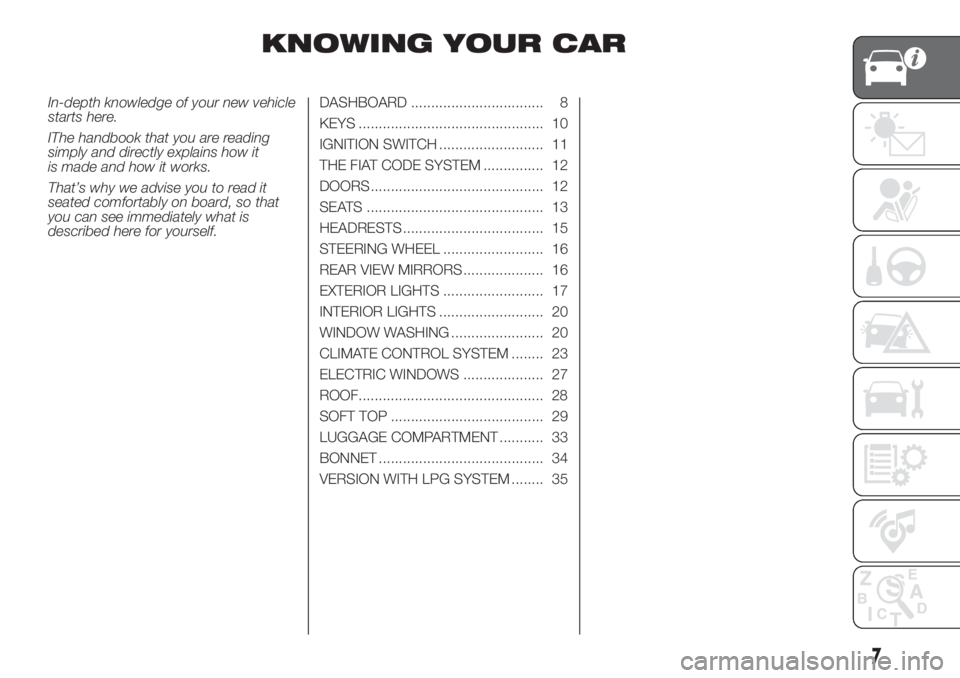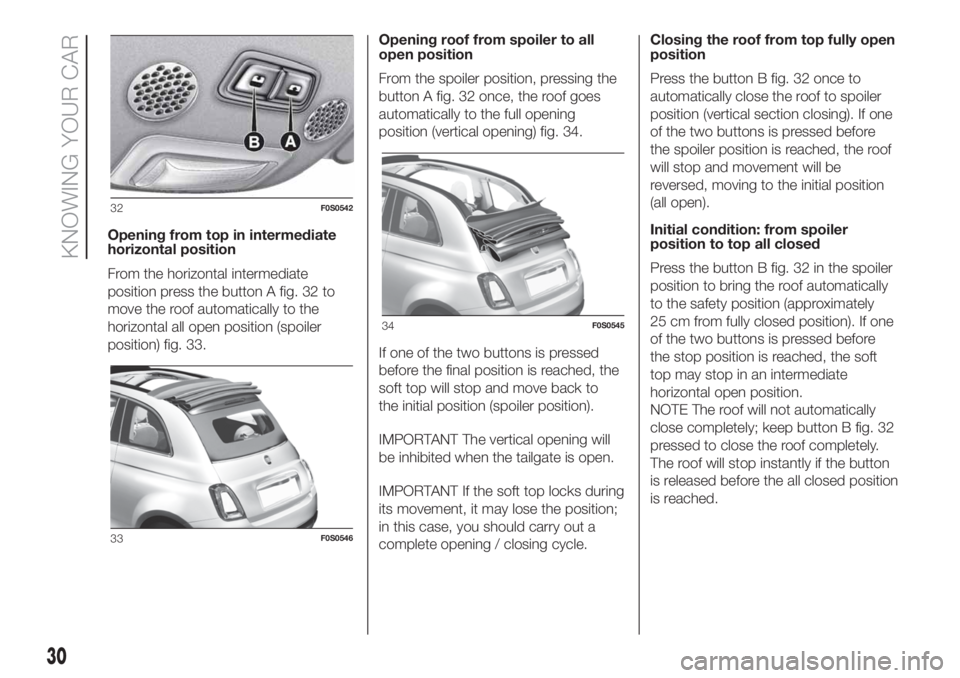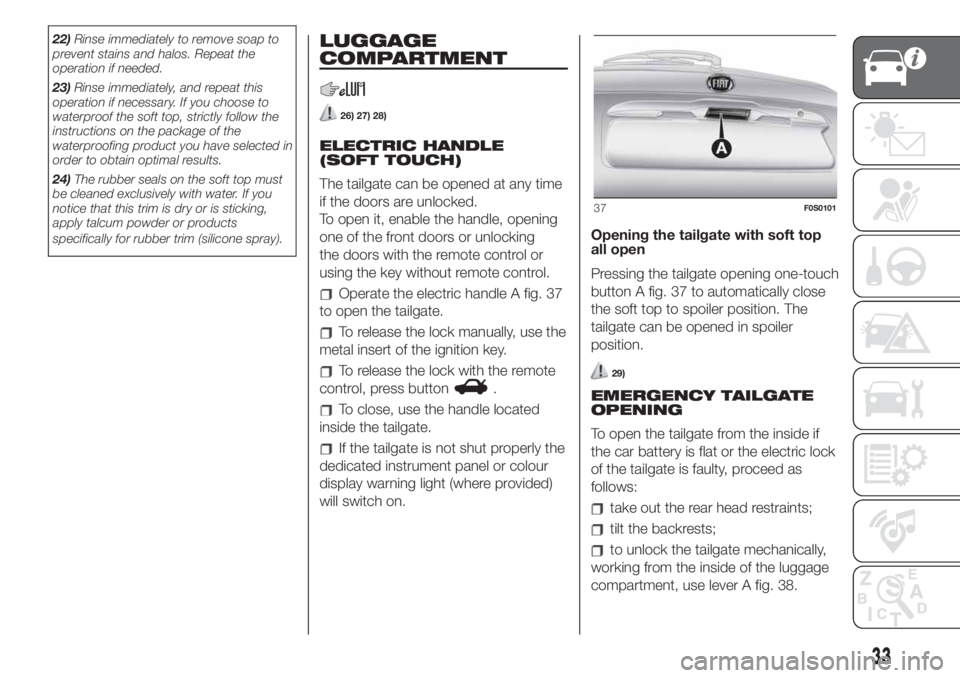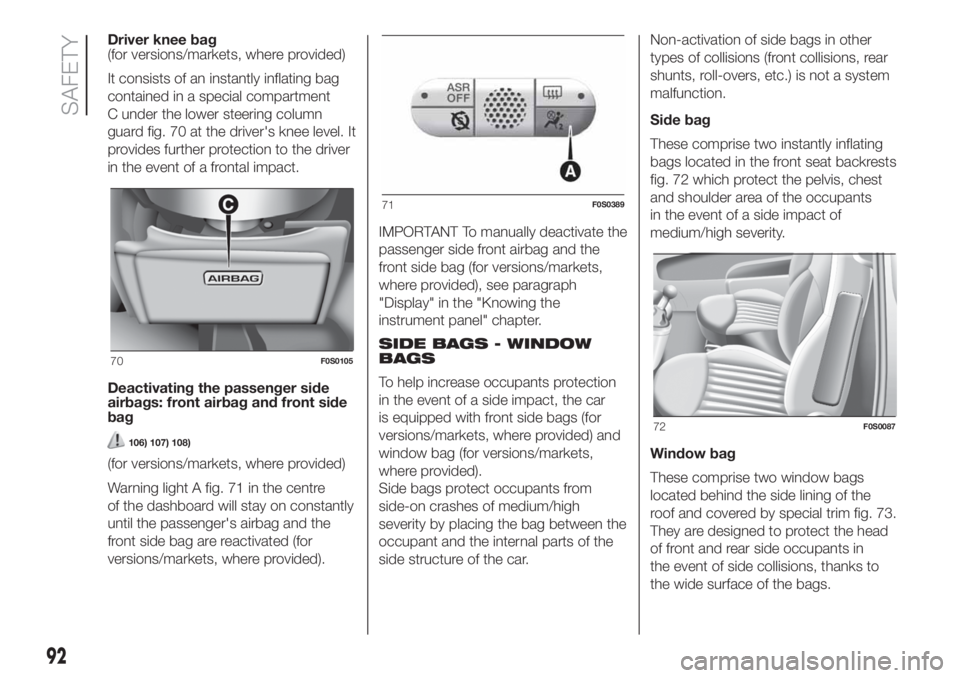roof FIAT 500 2020 Owner handbook (in English)
[x] Cancel search | Manufacturer: FIAT, Model Year: 2020, Model line: 500, Model: FIAT 500 2020Pages: 228, PDF Size: 6.01 MB
Page 9 of 228

KNOWING YOUR CAR
In-depth knowledge of your new vehicle
starts here.
IThe handbook that you are reading
simply and directly explains how it
is made and how it works.
That’s why we advise you to read it
seated comfortably on board, so that
you can see immediately what is
described here for yourself.DASHBOARD ................................. 8
KEYS .............................................. 10
IGNITION SWITCH .......................... 11
THE FIAT CODE SYSTEM ............... 12
DOORS ........................................... 12
SEATS ............................................ 13
HEADRESTS ................................... 15
STEERING WHEEL ......................... 16
REAR VIEW MIRRORS .................... 16
EXTERIOR LIGHTS ......................... 17
INTERIOR LIGHTS .......................... 20
WINDOW WASHING ....................... 20
CLIMATE CONTROL SYSTEM ........ 23
ELECTRIC WINDOWS .................... 27
ROOF.............................................. 28
SOFT TOP ...................................... 29
LUGGAGE COMPARTMENT ........... 33
BONNET ......................................... 34
VERSION WITH LPG SYSTEM ........ 35
7
Page 12 of 228

KEYS
1)
CODE CARD
(for versions/markets, where provided)
The car is delivered with two copies
of the ignition key and with the CODE
Card fig. 3 which bears the following:
A: the electronic code;
B: the mechanical key code to be given
to the Fiat Dealership when ordering
duplicate keys.
You should have the electronic code
with you at all times.
IMPORTANT All the keys and the
CODE card must be handed over to the
new owner when selling the car.MECHANICAL KEY
The metal insert A fig. 4 operates:
the ignition device;
the doors and the tailgate locks (for
versions/markets where provided);
the locking/unlocking of the fuel cap.
KEY WITH REMOTE
CONTROL
(for versions/markets, where provided)
The metal insert A fig. 5 operates:
the ignition device;
the door lock;
the locking/unlocking of the fuel cap.
Pressing button B fig. 5 allows the
opening/closing of the metal insert.
1)
Unlocking the doors and the
tailgate
Briefly press button
: for unlocking of
doors and tailgate, timed switching-on
of internal lights and double flashing
of direction indicators (for versions/
markets where provided).
The doors are unlocked automatically if
the fuel cut-off system intervenes.
Locking the doors and the tailgate
Brief press of the
button: remote
locking of doors and tailgate,
switching-off of roof light and single
flashing of direction indicators (for
versions/markets, where provided).
If one or more door are open, the doors
will not be locked. This is indicated by
a rapid flashing of the direction
indicators (for versions/markets, where
provided).
3F0S0002
4F0S0003
5F0S0004
10
KNOWING YOUR CAR
Page 30 of 228

ROOF
FIXED GLASS SUNROOF
(for versions/markets, where provided)
The roof comprises a wide fixed glass
panel and a manually-operated sun
blind. The blind can be used in the "all
closed" or "all open" positions.
To open the blind, grab the handle,
press the tooth A fig. 29 and move it to
the completely open position.
To close it, grab the handle and move
the blind to the closing position until
tooth A is attached.
SUNROOF
(for versions/markets, where provided)
22)
11) 12) 13)
To move the sunshade, follow the
instructions in “fixed glass roof”.Opening
Hold button A located near the front
ceiling light pressed fig. 30, to move the
roof to “spoiler” position.
With the roof open in “spoiler” position,
hold button A pressed again to move
the roof to all open position. The roof
will stop in the position reached when
the button is released.
Closing
Press button B fig. 30 from the all open
position: the front glass panel will move
into the “spoiler” position. The roof
will stop in the position reached when
the button is released. Hold button
B pressed again to reach the all closed
position of the roof.ANTI-PINCH DEVICE
The sunroof has an anti-pinch safety
system capable of detecting the
presence of an obstacle whilst the roof
is closing. When this happens, the
system stops and the movement of the
roof is immediately reversed.
INITIALISATION
PROCEDURE
The sunroof must be re-initialised after
disconnecting the battery or if the
relevant protection fuse is blown.
Proceed as follows:
press button B fig. 30 and hold it
down so that the roof closes
completely in stages
after full closing, wait for the sunroof
motor to stop.
EMERGENCY OPERATION
If the electrical device for moving the
roof fails, the sun roof can be moved
manually proceeding as described
below:
for manual activation remove the
protective cap A fig. 31 from its housing
which is located on the internal
covering behind the sun blind
take the Allen key provided from the
tool box in the boot
29F0S0097
30F0S0096
28
KNOWING YOUR CAR
Page 31 of 228

insert the key provided into housing
B fig. 31 and turn it clockwise to open
the roof or anticlockwise to close the
roof.
WARNING
22)When leaving the vehicle, always
remove the key from the ignition switch to
avoid the risk of injury to those still inside
the car due to accidental operation of
the sun roof. Improper use of the roof can
be dangerous. Before and during
operation, always check that no-one is
exposed to the risk of being injured by the
moving sunroof or by objects getting
caught or hit by it.
WARNING
11)Use the sun roof only at "spoiler"
position if a transverse roof rack is fitted.
12)Do not open the sun roof if there is
snow or ice on it: you may damage it.
13)Be careful not to hit objects on the
storage shelf when you open the tailgate.
SOFT TOP
Suggestions
it is advisable to close the soft top
when the car is parked. The closed soft
top effectively protects the car from
bad weather and from theft;
it is advisable to put valuables in the
boot and lock the lid even when the
top is closed.
SOFT TOP MOVEMENT
23) 24) 25)
14) 15) 16)
IMPORTANT The motor may overheat if
the soft top is repeatedly operated
within a short space of time, thus
causing the overheating protection to
inhibit system operation. Wait for a
minute and repeat.
Opening from roof fully closed
position
Press the button A fig. 32 once to open
the roof automatically to the horizontal
opening position (spoiler position).
If one of the two buttons is pressed
before reaching the spoiler position, the
roof may stop in an intermediate
horizontal opening position.
31F0S0098
29
Page 32 of 228

Opening from top in intermediate
horizontal position
From the horizontal intermediate
position press the button A fig. 32 to
move the roof automatically to the
horizontal all open position (spoiler
position) fig. 33.Opening roof from spoiler to all
open position
From the spoiler position, pressing the
button A fig. 32 once, the roof goes
automatically to the full opening
position (vertical opening) fig. 34.
If one of the two buttons is pressed
before the final position is reached, the
soft top will stop and move back to
the initial position (spoiler position).
IMPORTANT The vertical opening will
be inhibited when the tailgate is open.
IMPORTANT If the soft top locks during
its movement, it may lose the position;
in this case, you should carry out a
complete opening / closing cycle.Closing the roof from top fully open
position
Press the button B fig. 32 once to
automatically close the roof to spoiler
position (vertical section closing). If one
of the two buttons is pressed before
the spoiler position is reached, the roof
will stop and movement will be
reversed, moving to the initial position
(all open).
Initial condition: from spoiler
position to top all closed
Press the button B fig. 32 in the spoiler
position to bring the roof automatically
to the safety position (approximately
25 cm from fully closed position). If one
of the two buttons is pressed before
the stop position is reached, the soft
top may stop in an intermediate
horizontal open position.
NOTE The roof will not automatically
close completely; keep button B fig. 32
pressed to close the roof completely.
The roof will stop instantly if the button
is released before the all closed position
is reached.
32F0S0542
33F0S0546
34F0S0545
30
KNOWING YOUR CAR
Page 33 of 228

Initial condition: from intermediate
position to top all closed
Press the button B fig. 32 in the
horizontal intermediate position to bring
the roof automatically to the safety
position (approximately 25 cm from
horizontal all closed position).
Keep the button B fig. 32 pressed to
close the roof completely.
The roof will stop instantly if the button
is released before the all closed position
is reached.
IMPORTANT NOTES
The horizontal and vertical parts of
the soft top can be operated at any
speed lower than 100 and 80 km/h
respectively.
The top can be operated at any
temperature in the range from -18 to
+80 °C.
It is recommended to have the
engine running always when opening or
closing the soft top.
If required, remove the battery with
open or closed soft top, but NOT when
the soft top is moving.
Do not fix luggage transport devices
to the soft top and do not travel with
objects resting on the open top.
The activation of the heated rear
windscreen, upon request by the user,
is carried out only if the soft top is
completely closed. If the soft top is
closed incorrectly, the heated rear
window will not function and the
corresponding warning light will not turn
on.
When the soft top is opened using
the relevant control, if the heated rear
windscreen had been engaged it is
automatically deactivated and the
warning light switches off
Do not remove ice from the soft top
with a sharp item.
To prevent damage, do not use
scrapers or sprays to remove ice from
the heated rear window.
Do not put objects on the soft top:
they could fall if the it is operated,
causing damage and injury.
It is advisable to cover the soft top
with a protective sheet if the car is
left parked in the open for a long time.
Do not keep the soft top folded for a
long time: this could cause folds and
creases in the fabric.
Before moving the soft top, check
that there is enough room to carry
out the operation and that there are no
obstacles or people close to its moving
parts.
The cooled air flow into the
passenger compartment may decrease
if the automatic climate control system
is on and the top is not completely
closed.
With the soft top open and the car
travelling, the voice recognition system
may not recognise voice commands
because of the background noise: with
the soft top closed and at a high speed,
the voice function for number dialling
may not be recognised.
INITIALISATION
PROCEDURE
The soft top must be re-initialised after
disconnecting the battery or if the
relevant protection fuse is blown.
Proceed as follows:
before carrying out any other
operation, make sure the engine is on
during the whole initialisation
procedure;
keep the opening button pressed
until the soft top is completely open;
when the soft top is completely
open, keep the button pressed for at
least 2 seconds;
keep the closing button pressed
until the soft top is completely closed;
when the soft top is completely
closed, keep the button pressed for at
least 2 seconds.
31
Page 34 of 228

When the procedure is terminated, the
soft top will automatically carry out a
complete opening and closing cycle (up
to 25 cm from the completely closed
position) to inform the driver that
correct operation has been restored.
WIND STOP
To use the Wind Stop fig. 35:
Release the backrest of the rear seat
(single or split).
Attach the Wind Stop by inserting
the central part inside the rear screen
guard, with the concave part in the
direction of the occupant, as shown in
the figure fig. 35;
re-position the backrest correctly;
the Wind Stop is locked between
the seat and parcel shelf.FRONT SPOILER
The car is provided with a front spoiler
which can be raised to improve
aerodynamic comfort inside the
passenger compartment.
To lift the spoiler, release the catch by
means of the slider A moving it to
position 2 as shown in fig. 36.
WASHING/CLEANING THE
TOP
17) 18) 19) 20) 21) 22) 23) 24)
WARNING
23)Keep hands away from the top
mechanism while opening and closing the
top or if the top stops in a position before
completing the cycle to prevent damage
and injury.
24)Keep children away from the area in
which the top is folding during opening or
closing operations.25)When leaving the car, always remove
the key from the ignition device to avoid the
risk of injury due to accidental operation
of the soft top: improper use of the roof
can be dangerous. Before and during
operation, always check that no-one is at
risk of being injured by the moving soft top
roof or by objects getting caught and
dragged by it.
WARNING
14)Never open the top in presence of
snow or ice to prevent damage.
15)Do not place objects on the rear
window shelf to prevent damage while the
top is closing.
16)Loads may not be secured on the roof.
17)Bird droppings and plant resins must
be washed off immediately and thoroughly
as the acid they contain is particularly
aggressive.
18)Never use high-pressure washing
systems.
19)When using steam washers or
high-pressure water washers, maintain a
suitable distance and do not exceed a
maximum temperature of 60°C. Damage,
alterations and water infiltration may occur
if the distance is too small and the pressure
is too high.
20)If a water jet is used, direct away from
the edges of the fabric and the rear
window frame to prevent water infiltration.
21)Never use alcohol, petrol, chemical
products, detergents, stain removers, wax,
solvents and "wash and polish" products.
35F0S0550
36F0S0548
32
KNOWING YOUR CAR
Page 35 of 228

22)Rinse immediately to remove soap to
prevent stains and halos. Repeat the
operation if needed.
23)Rinse immediately, and repeat this
operation if necessary. If you choose to
waterproof the soft top, strictly follow the
instructions on the package of the
waterproofing product you have selected in
order to obtain optimal results.
24)The rubber seals on the soft top must
be cleaned exclusively with water. If you
notice that this trim is dry or is sticking,
apply talcum powder or products
specifically for rubber trim (silicone spray).LUGGAGE
COMPARTMENT
26) 27) 28)
ELECTRIC HANDLE
(SOFT TOUCH)
The tailgate can be opened at any time
if the doors are unlocked.
To open it, enable the handle, opening
one of the front doors or unlocking
the doors with the remote control or
using the key without remote control.
Operate the electric handle A fig. 37
to open the tailgate.
To release the lock manually, use the
metal insert of the ignition key.
To release the lock with the remote
control, press button
.
To close, use the handle located
inside the tailgate.
If the tailgate is not shut properly the
dedicated instrument panel or colour
display warning light (where provided)
will switch on.Opening the tailgate with soft top
all open
Pressing the tailgate opening one-touch
button A fig. 37 to automatically close
the soft top to spoiler position. The
tailgate can be opened in spoiler
position.
29)
EMERGENCY TAILGATE
OPENING
To open the tailgate from the inside if
the car battery is flat or the electric lock
of the tailgate is faulty, proceed as
follows:
take out the rear head restraints;
tilt the backrests;
to unlock the tailgate mechanically,
working from the inside of the luggage
compartment, use lever A fig. 38.
37F0S0101
33
Page 94 of 228

Driver knee bag
(for versions/markets, where provided)
It consists of an instantly inflating bag
contained in a special compartment
C under the lower steering column
guard fig. 70 at the driver's knee level. It
provides further protection to the driver
in the event of a frontal impact.
Deactivating the passenger side
airbags: front airbag and front side
bag
106) 107) 108)
(for versions/markets, where provided)
Warning light A fig. 71 in the centre
of the dashboard will stay on constantly
until the passenger's airbag and the
front side bag are reactivated (for
versions/markets, where provided).IMPORTANT To manually deactivate the
passenger side front airbag and the
front side bag (for versions/markets,
where provided), see paragraph
"Display" in the "Knowing the
instrument panel" chapter.
SIDE BAGS - WINDOW
BAGS
To help increase occupants protection
in the event of a side impact, the car
is equipped with front side bags (for
versions/markets, where provided) and
window bag (for versions/markets,
where provided).
Side bags protect occupants from
side-on crashes of medium/high
severity by placing the bag between the
occupant and the internal parts of the
side structure of the car.Non-activation of side bags in other
types of collisions (front collisions, rear
shunts, roll-overs, etc.) is not a system
malfunction.
Side bag
These comprise two instantly inflating
bags located in the front seat backrests
fig. 72 which protect the pelvis, chest
and shoulder area of the occupants
in the event of a side impact of
medium/high severity.
Window bag
These comprise two window bags
located behind the side lining of the
roof and covered by special trim fig. 73.
They are designed to protect the head
of front and rear side occupants in
the event of side collisions, thanks to
the wide surface of the bags.
70F0S0105
71F0S0389
72F0S0087
92
SAFETY
Page 95 of 228

Important notes
In the event of a side impact, the
system provides best protection if the
passenger sits on the seat in a correct
position, thus allowing correct window
bag deployment.
The front airbags and/or side bags may
be deployed if the car is subject to
heavy knocks or accidents involving the
underbody area, such as for example
violent shocks against steps,
pavements or low obstacles, the car
falling in big holes or dips in the road.A small amount of dust will be released
when the airbags are deployed. The
dust is not harmful and does not
indicate the beginning of a fire.
Furthermore, the surface of the
deployed bag and the interior of the car
may be covered by a dusty residue:
this may irritate skin and eyes. Wash
with neutral soap and water in the
event of exposure
Every control, repair and replacement
operation concerning the airbags must
only be carried out at a Fiat Dealership.
If the car is scrapped, have the system
deactivated at a Fiat Dealership.
Pretensioners, front airbags and side
bags are deployed according to
different logics on the basis of the type
of crash. Failure to activate one or
more of the devices does not indicate a
system malfunction.
Should an accident occur in which any
of the safety devices are activated,
take the car to a Fiat Dealership to have
the activated devices replaced and to
have the whole system checked.
109) 110) 111) 112) 113) 114) 115) 116) 117) 118)
119) 120)
WARNING
102)Do not apply stickers or other objects
on the steering wheel, on the dashboard
in the passenger side airbag area, on
the side upholstery on the roof and on the
seats. Never put objects (e.g. mobile
phones) on the passenger's side
dashboard since they could interfere with
correct inflation of the airbag and also
cause serious injury to the passengers.
103)Always drive with your hands on the
rim of the steering wheel so that the airbag
can inflate freely if required. Do not drive
bent over the steering wheel, but rather sit
upright with your back firmly resting against
the seat back.
104)When an active passenger airbag is
fitted, DO NOT install rear facing child
restraint systems on the front seat.
Deployment of the airbag in an accident
could cause fatal injuries to the child
regardless of the severity of the impact.
105)When there is an active passenger
airbag, DO NOT install rearward facing
child restraint systems on the front seat.
Deployment of the airbag in a crash could
cause fatal injuries to the child regardless
of the severity of the collision. It is advisable
to always carry children in a child restraint
system on the rear seat, which is the
most protected position in the event of a
collision.
73F0S0106
93